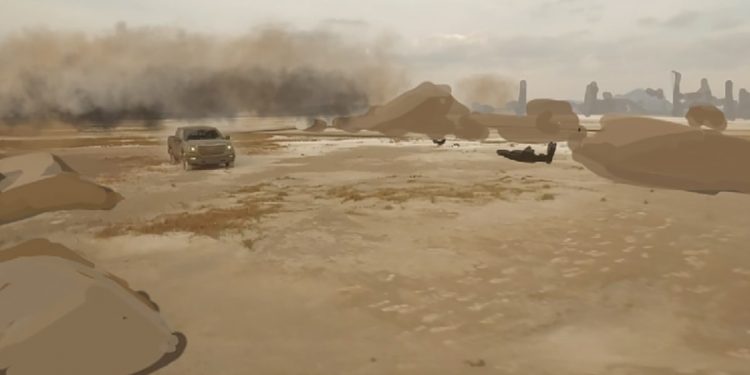Visual effects artist Ludovic Iochem is a regular professor at fxphd, You may have already taken one of his fantastic matte painting courses. This January 2016 term, Ludovic is back with not one but two incredible courses. The first is the 200 level DMP208: Digital Matte Painting: The Abandoned Environment, in which Ludo will create a full shot from scratch inspired by the latest Star Wars movie. Then in VFX305: Advanced VFX: The Desert Truck Scene, he’ll produce a desert shot with a truck plate, matchmoved camera, environment, distant city and sand storm. Both courses are going to be full of detailed tuition.
But how did Ludo get here? We’ve talked to the VFX artist previously on the fxphd blog, so we thought we’d re-visit that chat and also hear more about Ludo’s journey from studying in France to working in London at Double Negative to his upcoming move to Head of Environment at Framestore in Montreal.
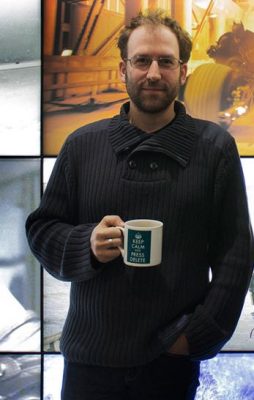
fxg: Tell us about your new role you’re taking up in Montreal? How do you feel about the vfx community that has really become so big in that city?
Ludovic Iochem: I’m going to be Head of Environment in Montreal Framestore’s facility. It means I’ll be in charge of the Environment department, will make sure everything works as expected between Environment and the other departments. I will help the leads to manage their teams, achieve their deliveries, and will make sure we keep a strong connection with the Env Department from the London facility. I’ll be on shows as well, but will be the main contact for everyone who has something to share with Environment.
fxg: Can you talk about the design of your Digital Matte Painting: The Abandoned Environment course? What are some things students can look forward to with it?
Ludovic Iochem: For this term, I wanted to work on a shot from the last Star Wars movie I quite liked. So we’ll start with a bit of image analysis, then we’ll jump into modeling/UV. We’ll do a bit a texturing and will use Arnold to generate a lighting pass. Then we’ll go into Photoshop to merge everything in a DMP that we’ll reproject on a geometry in Nuke to add a bit of movement. After last term dedicated to 2D DMP only, I wanted to go back into something a bit more technical.
fxg: Tell us about how the Advanced VFX: The Desert Truck Scene will work over two semesters?
Ludovic Iochem: This project is a very challenging project. We’ll be working on a long traveling shot over a truck in a desert, with some set extension, DMP, and FX. We’ll go through the entire process of a big shot, like the ones you’ve seen on Mad Max. I think it will be a good way to see how Modeling, Texturing, LookDev, Lighting, FX, DMP, and comp are working together to deliver the best of a shot. We decided to run it on 2 terms because of the complexity of the shot. We wanted to take time to explain every techniques. The FX part itself will be very challenging!
fxphd: How did you get started in the VFX industry?
Ludovic Iochem: I’ve been very lucky. After having studied sciences and programming at high school, I decided to try to enter into the big French Films schools (Louis Lumiere and FEMIS). But it didn’t work, and I decided to go into a University which proposed a generalist CG training. I didn’t really know what I would do next, but I stayed there for few years, exploring different routes, from Photo manipulation to 3D, and MEL scripting. I’ve directed a lot of short films and have been very interested into the use of the new techniques on stage, and the way to create some emotions through these new techniques.
I started a PHD on this subject, but it didn’t really work, everything was moving really fast, and I couldn’t reduce my subject to something specialized enough to be interesting. One day, I came back home and started to do some matte painting. I was a big fan of this technique because I used to watch the TV Show “Movie Magic” which was presenting a lot of matte painting and glass painting from movies in the 80’s and 90’s. So I decided to train to do some matte painting for my own, thinking that there wasn’t any matte painting work in France anyway. I only knew few big names at this time, like Yannick Dusseault and Dylan Cole. I knew the work of Matte World Digital, and that was it. But when I started to look at the VFX companies, I discovered there were few French matte artists, 3 or 4 around Paris. I contacted one of them, from the studio Mikros Image, and I started to show him my work. I kept working like this, alone, at home, during few months, trying to reproduce some matte painting I found on the internet, and one day, I started at Mikros Image as a matte painter, and that’s how everything started.
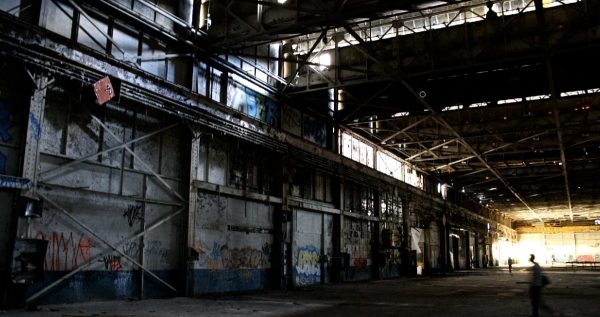
fxphd: You’ve been able to work on several productions and at different studios – what have you found interesting about working on large effects-heavy movies but also more ‘invisible effects’ ones too?
Ludovic Iochem: I started in France, where we don’t have very big projects. VFX is still an area where there is not much money allowed, and you need to be very clever to be able to deliver what the director wants, in time, in the budget. And that’s why I loved working in Paris because you have to know every cheat, all the way to turn around the problems and avoid them. It’s a very good school for VFX artists because you need to be very very creative to be able to achieve the job.
Generally, I prefer the invisible effects. I really enjoyed working on Bourne Ultimatum and Quantum of Solace for this. There are less VFX shots, the team is smaller, but it’s quite challenging to do something in order to people don’t see anything. I like being in a cinema, watching a movie, and think “well, here, everything is just a big DMP, but I’m the only one to know.”
Working on very large show, like Thor, is also very interesting because of the amount of work we need to achieve. The team is huge, deadlines are tight, and the work is very challenging. It’s more about defining the best pipeline depending of the people available, and the time you have. So I would say, you really can find some interest in all the type of project, but it’s good to change. I wouldn’t like to do always the same type of films.
fxphd: Can you discuss some of the shots you worked on for Thor: The Dark World and other recent projects?
Ludovic Iochem: I haven’t done a lot of shots myself on Thor, as I was leading the team, which was pretty big, but I managed to pick a few at the end. I worked on a night shot flying over Asgard with the Arkship revealing itself. It was a CG render that I turned into night. Then, I’ve added a lot of small lights everywhere. It was a nice shot to do. I also worked on some background mountains during the skiffs chase, and the interior of a mountains, full of statues, that Thor and Loki cross during the chase. For the rest of work, the Env team delivered a huge amount of shots in total, a lot of skies, background mountains, set extension of corridor, city, night and day, some big cyclorama of Asgard, some planets shot from the space, a lot of different type of shots actually. I’m very proud of what we’ve all achieved on this project, it’s been a wonderful experience for me. I learnt a lot as well. In the last couple of years, I’ve been involved mainly on Terminator Genisys, which took me a lot of time. Then I’ve worked a little bit on various project to help, and more recently I worked on the Star Trek trailer. It was quite fun.
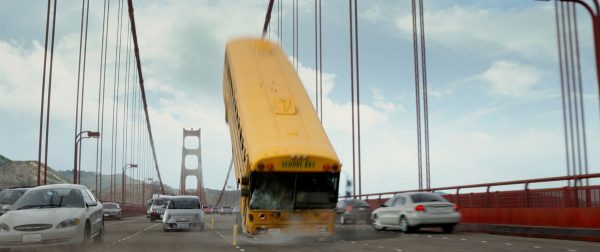
fxphd: At an overall level, what do you think are some of the most important considerations when approaching a digital matte painting shot?
Ludovic Iochem: I’d say, you need to focus on what is important. Sometimes, it’s not easy to find out, but it’s the key to sell the shot. Of course, you have to respect the basics, like perspectives, lighting, composition. Everything needs to be perfect at this level, otherwise it won’t work, but most of the time, nobody really knows in advance how the shot needs to look exactly. The brief is pretty vague, and the first version is really important to lock the look and the direction. You need to propose something, which isn’t necessary what you love the most, but which needs to be what you think the client wants. So it’s always good to see the previous shots that has been approved, the concepts, the production references, etc. You need to understand the shot, before you’re start to work on the details.
fxphd: What tools have you been traditionally using in your work – and what are you excited to try out in the near future? What still needs to be worked on, do you think, in terms of tools?
Ludovic Iochem: The main tools in Environment today are Photoshop, Maya and Nuke. We always have to jump from one to another one. Most of the time, I prep my layers in Photoshop, and assemble them in Nuke. On the top of this, now we also need to use MARI, and sometimes we can play with other software like Vue, Mudbox or Painter for very specific tasks. I’ve been testing a few other pieces of software recently which seem to be very interesting like Photoline, which is a 32b float painter, Krita, another painting software, and Clarisse, a stand alone renderer which allows you to actually do pretty much all your shot in a very clever way.
Everything is going very fast lately, especially around the renderer, which is becoming really interactive. In the future, I’d love to get something which allows you to light and render your scene, bring this render into a painting tool, let you work on it as you would do in Photoshop, and let you re-project it with the flexibility and the interactivity of Nuke.
fxphd: When did you first come into contact with fxphd?
Ludovic Iochem: I’ve known fxphd for a long time, because I read fxguide and listen to the podcast. A few months ago, we launched DMPCoach with Nick, a forum board that we use to organize DMP Workshop. One of the members is also a member of fxphd and one day he told us we should contact fxphd. But before we did that, we w’ere contacted by John, who proposed teaching the Advanced Matte Painting course to us. It was a great opportunity for us to keep doing what we like: sharing something we’re really into.
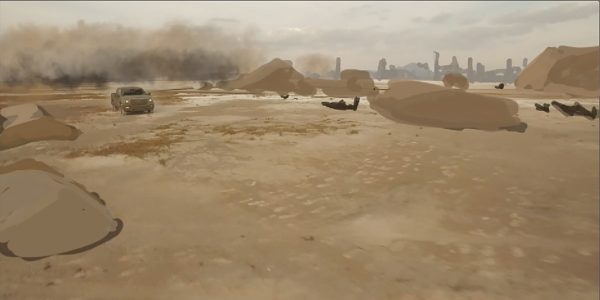
fxphd: Do you spend time on personal projects, both in terms of any digital work or on outside activities?
Ludovic Iochem: I don’t really have the time no. I’d love to do more photography, because that’s something I really like, but when I’m home, I prefer to spend my time with my family, playing with Pirates ship, Dragons, and Knights 🙂
fxphd: Any pieces of advice for aspiring matte painters/compositors looking to get started in visual effects?
Ludovic Iochem: Work, try, test, and practice, everything, and always, because the VFX world is going so fast, that you need to be really flexible, polyvalent, in your way of thinking. I don’t think everyone should know how to do a shot from the matchmove to the final comp, but again, to me, it’s crucial to have a very good understanding of every stage of a production. And there is nothing better than trying yourself something to understand where are the issues, and where are the answers.
Find out more about DMP208: Digital Matte Painting: The Abandoned Environment and VFX305: Advanced VFX: The Desert Truck Scene and other fxphd courses at our course overview page.
